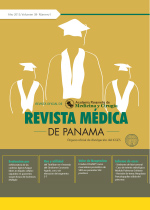Registro hospitalario de la enfermedad cerebro-vascular en Panamá: Estudio prospectivo en dos hospitales de referencia en la Ciudad de Panamá y programa de terapia trombolítica endovenosa como política de salud pública.
Autores/as
DOI:
https://doi.org/10.37980/im.journal.rmdp.2013131Resumen
Introducción ─ La enfermedad cerebro vascular es una de las principales causas de muerte e incapacidad en Latinoamérica. Actualmente en Panamá es la cuarta causa de muerte. El objetivo de este estudio es caracterizar la enfermedad cerebrovascular en Panamá.
Método ─ Se realizó un estudio prospectivo, de cohorte, en pacientes con ictus de cualquier tipo de novo o recidivante, entre junio 2005 y junio 2006. Se aplicó un instrumento a pacientes de ambos sexos y mayores de 15 años de edad, previo consentimiento escrito que incluyó: aspectos demográficos, clínicos, diagnósticos y evolución.
Resultados ─ El 55% (297/542) cumplieron con los criterios de inclusión del estudio de los cuales 166 eran del HST y 131 de la CSS, la media de edad fue de 67 años y la razón hombre/mujer fue 1:1.1. El 63.3%(188) fueron isquémicos, 24.2%(72) hemorrágico, 6.4%(19) isquemia cerebral transitoria y 4.0%(12) hemorragias subaracnoidea. La hipertensión arterial fue el factor de riesgo más frecuente (73%). El 8% de los que presentaron ECV isquémica llegaron al hospital antes de las 3 horas de iniciado los síntomas y solo el 3%(7) fueron elegibles para terapia trombolítica IV. La principal complicación fue la broncoaspiración en un 26%(62/241) y la mortalidad intrahospitalaria fue de 28.4% (75/264).
Conclusión ─ La enfermedad cerebrovascular es una enfermedad catastrófica en Panamá con alta morbimortalidad los factores de riesgo y subtipos son similares en los reportados en otros estudios latinoamericanos. Desde el 2013, como política de salud pública, ambos hospitales inician su programa de terapia trombolítica endovenosa.
Hospital registry of cerebrovascular disease in Panama: A prospective study in two referral hospitals in Panama City and intravenous thrombolytic therapy program as public health policy.
Summary
Introduction The cerebrovascular disease is a major cause of death and disability in Latin America. Panama is currently the fourth leading cause of death. The aim of this study is to characterize cerebrovascular disease in Panama.
Method: a prospective cohort study was conducted in patients with stroke of any de novo or recurrent, between June 2005 and June 2006. An instrument was applied to patients of both sexes and over 15 years of age, prior written consent which it included: demographic, clinical, diagnostic and evolution.
Results: 55% (297/542) met the study inclusion criteria of which 166 were from the HST and the CSS 131, the average age was 67 years and the male / female ratio was 1: 1.1. 63.3% (188) were ischemic, 24.2% (72) bleeding, 6.4% (19) transient cerebral ischemia and 4.0% (12) subarachnoid hemorrhage. Hypertension was the most frequent risk factor (73%). 8% of those with ischemic CVD arrived at the hospital before 3 hours of onset of symptoms and only 3% (7) were eligible for thrombolytic therapy IV. The main complication was aspiration in 26% (62/241) and in-hospital mortality was 28.4% (75/264).
Conclusion: Cerebrovascular disease is a catastrophic illness in Panama with high morbidity and mortality risk factors and subtypes are similar to those reported in other Latin American studies. Since 2013, public health policy, both hospitals begin their program of intravenous thrombolytic therapy.
Key Word: Cerebrovascular disease, stroke, Panama, thrombolytic therapy, hospital record.
Publicado
Número
Sección
Licencia
Derechos autoriales y de reproducibilidad. La Revista Médica de Panama es un ente académico, sin fines de lucro, que forma parte de la Academia Panameña de Medicina y Cirugía. Sus publicaciones son de tipo acceso gratuito de su contenido para uso individual y académico, sin restricción. Los derechos autoriales de cada artículo son retenidos por sus autores. Al Publicar en la Revista, el autor otorga Licencia permanente, exclusiva, e irrevocable a la Sociedad para la edición del manuscrito, y otorga a la empresa editorial, Infomedic International Licencia de uso de distribución, indexación y comercial exclusiva, permanente e irrevocable de su contenido y para la generación de productos y servicios derivados del mismo. En caso que el autor obtenga la licencia CC BY, el artículo y sus derivados son de libre acceso y distribución.






